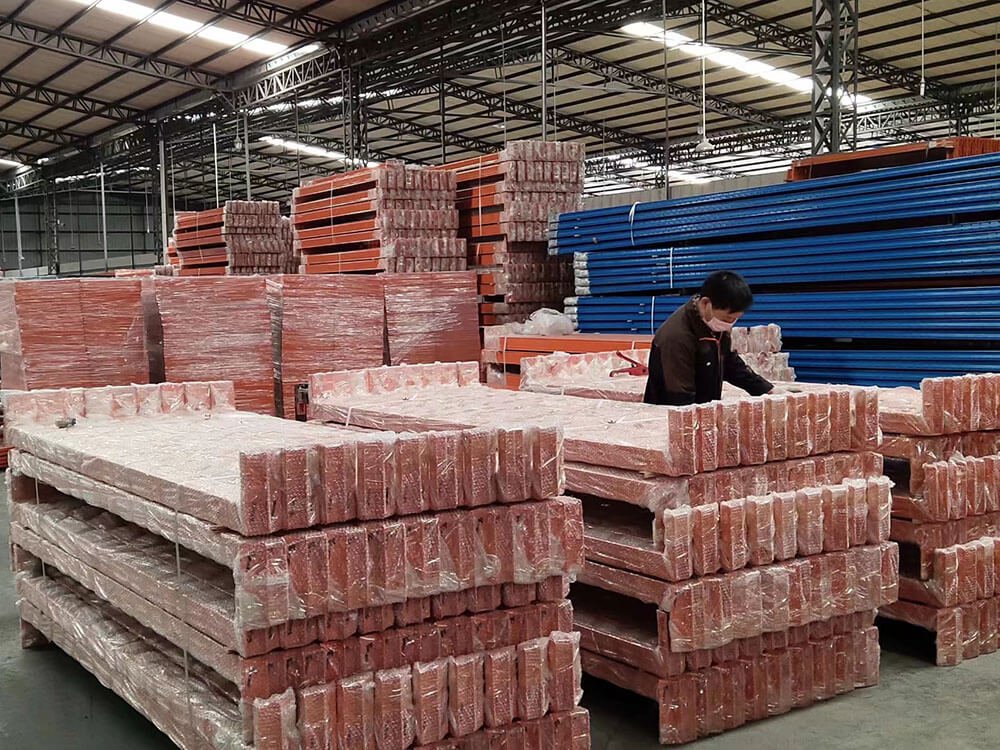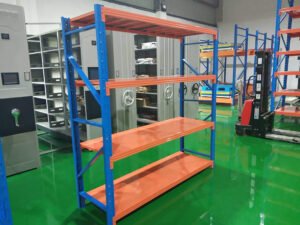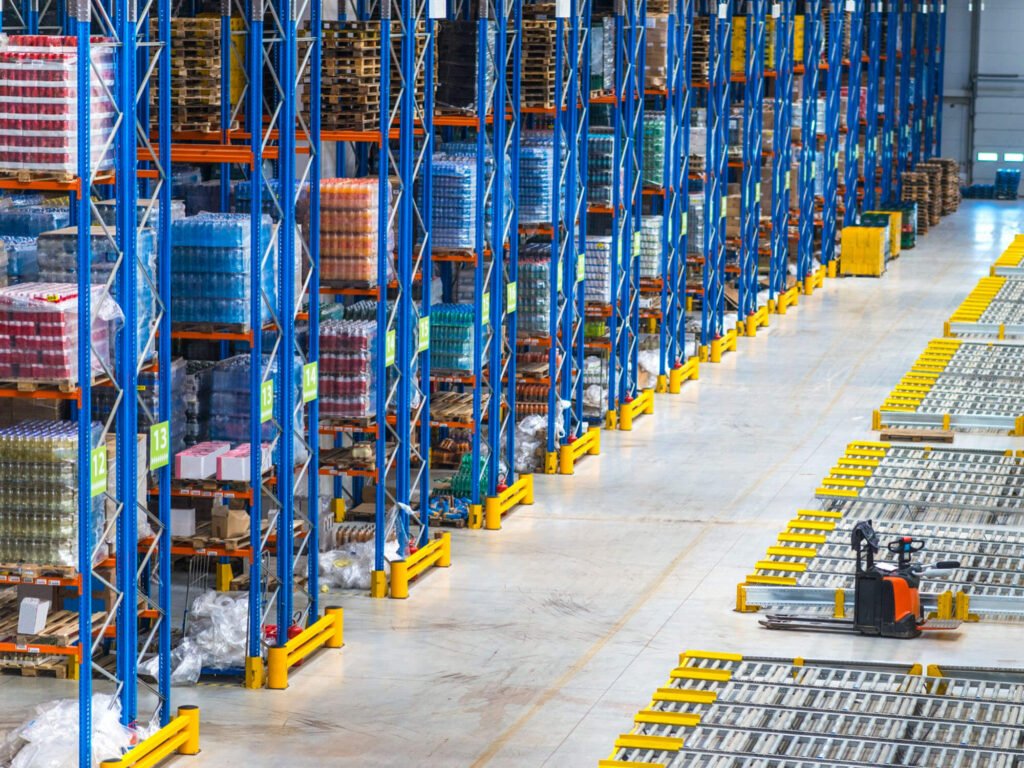Have you ever walked into a warehouse and wondered what the horizontal bars that hold up all those pallets are called? Well, they’re pallet racking beams, and they serve as the foundation of your pallet racking system, keeping your inventory organized, accessible, and secure.
But selecting the appropriate pallet racking beams is not an easy task. It’s similar to finding the ideal pair of shoes when everything comes down to finding the proper fit for your individual requirements.
This article will delve into the world of pallet racking beams, covering their many kinds, materials, and features. It’ll also address frequently asked questions like “What’s the difference between step beams and box beams?” and “How much weight can a pallet racking beam actually hold?”
Plus, there will be some professional tips and tactics to help you make an educated choice and keep your warehouse functioning at top performance. Get ready to learn about pallet racking beams and how they can improve your storage game!
Understanding Pallet Racking Beams
Pallet racking beams may seem basic, but they’re the true workhorses of any storage system. They’re what your pallets sit on, so selecting the proper ones is critical to keeping your warehouse operating efficiently and securely.
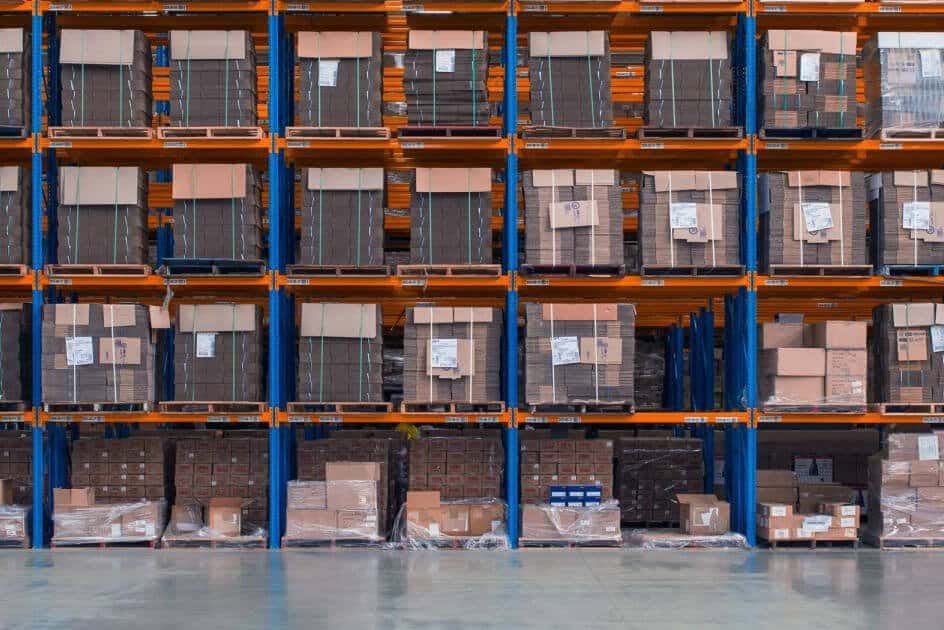
What Are The Different Types Of Pallet Racking Beams
Like automobiles, pallet racking beams come in various kinds, each of which has distinct advantages. Therefore, you should analyze your personal requirements before making a selection. The following are some of the most frequent ones you may encounter:
- Step beams: These are the most common sort of beam, and with good reason. They’re adaptable and simple to modify, making them ideal for warehouses that store a wide range of items. Plus, they include tiny “steps” around the top to help hold your pallets in place.
- Box beams: If you’re dealing with really large weights, box beams are your go-to. They’re very tough and durable due to their closed-off, box-like form.
- Structural beams: These beams function similarly to bodybuilders in the pallet racking sector. They’re built of heavy-duty steel and can withstand the most rigorous storage conditions.
What Materials Are Pallet Racking Beams Made Of?
Most pallet racking beams are composed of steel. But there are still other varieties to pick from. The kind of steel you choose will determine the strength, longevity, and cost of your pallet racking beams.
- Hot-rolled steel: This is the industry standard for pallet racking beams, providing a sturdy and lasting solution at an affordable price. Hot-rolled steel is produced by rolling molten steel through a succession of rollers at high temperatures to produce a thick, homogeneous material capable of bearing large weights.
- Roll-formed steel: This form of steel is created by continually passing cold steel coils through a series of rollers that shape them into a certain profile. Roll-formed steel beams are lighter and simpler to handle than hot-rolled steel. However, they may not be appropriate for holding exceptionally large loads.
- High-strength steel: As the name implies, high-strength steel is designed to offer greater load-bearing capability. It is accomplished using a mix of alloying elements and specialized production techniques. Despite being more expensive, high-strength steel beams are ideal when you’re dealing with really heavy palletized products.
How Do Pallet Racking Beams Work?
Consider pallet racking beams to be considerably bigger versions of your kitchen pantry shelves. They connect to the vertical uprights of your pallet racking system to form the levels where you store your pallets.
The beams are intended to uniformly distribute the weight of your pallets, ensuring that your racking system is sturdy and secure. However, it’s critical to choose pallet racking beams with the proper load capacity for your application. Overloading them will result in severe accidents.
How To Calculate Beam Load Capacity?
Figuring out how much weight your pallet racking beams can support is essential for preventing a collapse! Here’s a straightforward, step-by-step approach for how you can figure out this figure:
- Measuring beam length: Using a tape measure, determine the distance between the connecting brackets of your beam. It’s the gap between the uprights after the beam is mounted. Don’t measure the whole beam, just the usable portion.
- Identifying the profile number: This is similar to determining the brand and model number of your television. The profile number is normally stamped on the beam and provides information about its thickness, gauge, and other specifications. This number is your passport to obtaining the ideal capacity chart.
- Doing the detective work: If you can’t locate the profile number, don’t worry! Look for indicators like beam type (step, box, etc.), thickness, steel gauge, and even safety lock style. These indications will help you identify the maker and generation of your beam, thereby pointing you to the appropriate chart.
- Decoding the capacity chart: Now comes the fun part! Locate the row and column on the chart that correspond to your beam length and profile number. The figure you see there is the weight capacity of a pair of beams. Remember that in selective racking, beams usually function in pairs.
If manual computation looks daunting, fear not! There are many online calculators that can help you estimate the load capacity of your pallet racking beam. These user-friendly sites typically ask for the beam’s size, material, and configuration.
Despite being a quick and simple method of calculating the number, visit a pallet racking specialist for correct estimates and effective guidance.
Factors To Consider When Choosing Pallet Racking Beams
Now that you’ve learned about the basics of pallet racking beams and how to calculate their weight capacity, let’s go further into the main variables to consider when selecting the correct beams for your warehouse. Though things can get a bit complicated here, don’t worry. This section will explain everything, so it’s easy to understand.
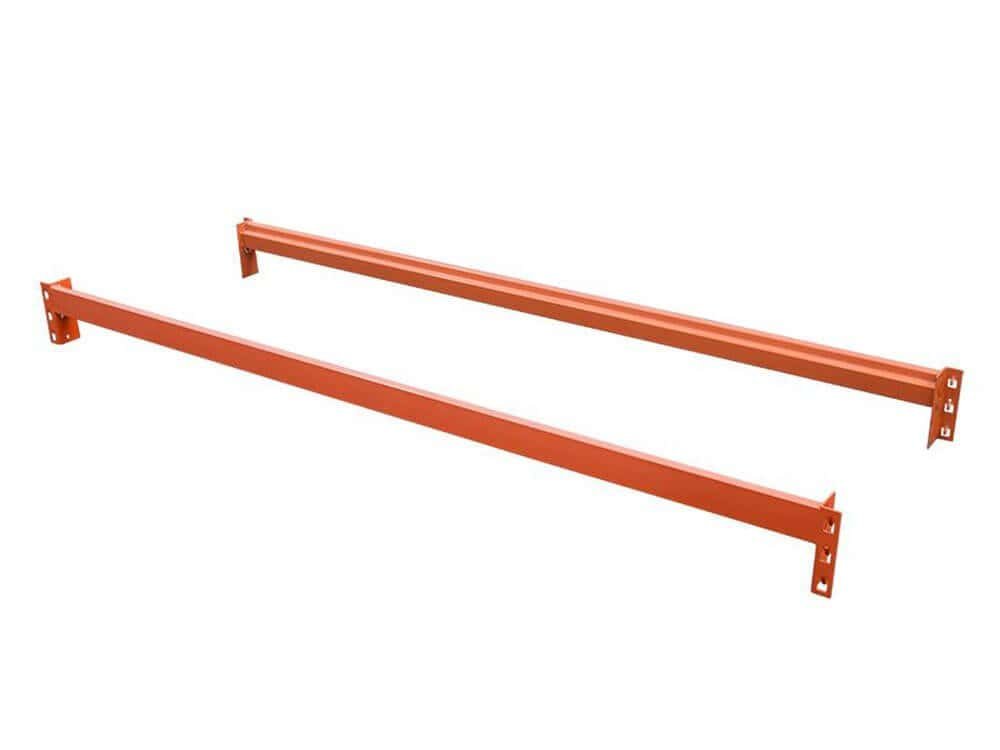
#1: Assessing The Load Capacity Of The Beams
Your pallet racking beams must be sturdy enough to carry the weight of your pallets and contents. Hence, selecting beams with the appropriate load capacity is critical. In addition to determining the required figure, you should also assess the following factors:
- Checking weight distribution: If the weight on your pallet is concentrated in one spot, such as a huge engine block strapped to one corner, that corner will put more strain on the beam underneath it. To compensate for this concentrated load, you’ll need a beam with a larger capacity than if the weight were uniformly spread throughout the whole pallet.
- Considering pallet load dimensions: Wider pallets result in a bigger lever arm, which increases the tension on the beams. Similarly, the heavier your pallet (or lever arm), the more weight the beams must be able to support. So, even if your broad pallet weighs the same as a narrower one, you will still need beams with a larger load capability to hold it.
#2: Selecting The Right Beam Length
The length of your pallet racking beams is the distance between the vertical uprights of your racking system. It must be just appropriate to ensure your warehouse’s stability and safety. Hence, choosing the proper beam length is based on various criteria, including:
- Aisle width: A short aisle width may be more space-efficient, but it might cause congestion and accidents if your forklifts do not have enough area to maneuver safely. On the other side, very broad aisles will squander important storage space. The appropriate aisle width is determined by the kind of equipment you employ, the size of your pallets, and your overall warehouse plan.
- Pallet load dimensions: The length and width of your pallets will directly affect the beam length you need. Longer pallets require a longer beam to provide appropriate support. If your beam length is insufficient for your pallets, they will overhang the edges, which is hazardous and unsafe. If your beam is too lengthy, you will be losing important storage space.
- Load capacity: Longer beams can hold less weight than shorter beams. That’s because they tend to bend and sag under pressure. So, if you have to store large pallets, you’ll probably require shorter beams with greater load capability. If you’re storing lighter pallets, longer beams with a lesser load capacity will be sufficient.
When picking the correct beam length, the 96-inch beam is the most common option. It can support two conventional 40-inch-wide pallets, with enough room for load width changes. But if you often handle larger pallets, consider longer beams to provide enough support and prevent dangerous overhangs.
#3: Setting The Appropriate Beam Spacing
Have you ever tried to put a huge product into a tiny space? Is it not enjoyable? The same principle applies to pallet racking beam spacing. The space between them must be “just right” for easy access and inventory.
To determine this sweet spot, add your loaded pallet height to the beam thickness, plus at least 4 inches of lifting space. While 4 inches may suffice, 6 inches provides additional wriggle space, particularly for bigger pallets or for loading at higher heights.
Remember to measure beam level from the top of one beam to the top of the next. This simplifies things since beam thicknesses vary, but the top will always align with the upright’s holes.
#4: Determining The Type Of Product Being Stored
Here’s a fact: the sort of goods you are storing will determine the type of beam you need. For example, if you’re storing palletized items, a box beam or a structural beam is an excellent choice, as they offer a firm platform and are easily adjustable to fit various pallet sizes.
But if you’re storing drums or boxes, you may want a different kind of beam, such as step beams. These beams are built to withstand greater weights and can be customized to provide unique inventory options.
You should also examine any specific needs your items may have, such as temperature control or fire safety. Certain beam types are better suited to these specialized settings.
#5: Considering Your Budget
Let’s face it: budget is always an important consideration. The price of pallet racking beams varies according to their material, size, and characteristics. Hence, it’s critical to achieve a balance between cost and quality.
While it may be tempting to select the most economical choice, investing in high-quality beams may save you money in the long run. They may be more expensive initially, but they’ll last longer and need fewer repairs, thus saving you money over time.
If you have a restricted budget, consider options such as secondhand or reconditioned beams. These solutions might be fantastic ways to get high-quality beams at a low cost.
Pallet Racking Beam Safety And Maintenance
Your job is not complete yet. Remember that safety always comes first, and maintaining your beams is critical to making your warehouse a safe and efficient working environment. Let’s start off by following the below practices:
Ensuring The Safety Of Your Pallet Racking System
Regular inspections and maintenance are essential for keeping it in good working order and avoiding safety hazards. Here’s a brief beam-related checklist of what to look for during your inspections:
- Damaged beams: Keep a watch out for dents, bends, and fractures in your beams. These may degrade the beam’s structural integrity and increase its susceptibility to pallet racking failure.
- Missing or loose safety clips: If these small but mighty pieces are missing or loose, your whole pallet racking structure might fail. Thus, make sure you undertake a frequent check-up to guarantee that all of the safety clips are present and functioning properly.
- Overloaded beams: This is a big no-no! Overloading your beams can cause them to droop or even shatter, resulting in major accidents. Always follow the load capacity markings on your beams to ensure you’re not going over the limit.
- Corrosion: If you’re utilizing steel beams, keep an eye out for symptoms of rust and corrosion. These might weaken the material, making it more vulnerable to damage.
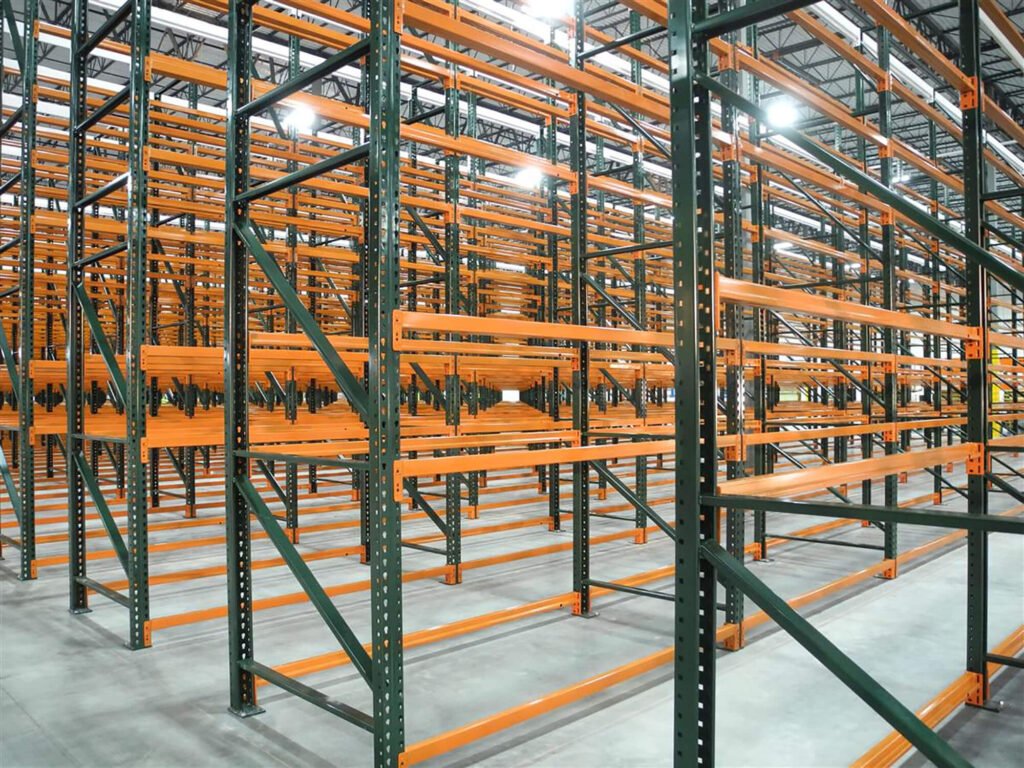
Complying With The Safety Regulations For Pallet Racking Beams
Pallet racking safety follows the same standards as driving on the road. These restrictions are in place to safeguard your employees and inventory, so take them carefully.
Proper labeling is an important part of pallet racking safety. Make sure your beams have visible load capacity markings so that your employees understand how much weight they can safely hold. You should also place safety signs around your warehouse to inform employees about safe operating methods.
Complying with safety laws is more than just avoiding fines and penalties. It’s about providing a safe and secure work environment for your workers. By following the guidelines, such as the ANSI MH16.1-2023 document, and properly maintaining your pallet racking system, you can reduce the risk of accidents and guarantee that your warehouse runs smoothly and effectively.
Expert Tips For Choosing Pallet Racking Beams
Before wrapping things up, here are some killer suggestions to help you make your warehouse storage ambitions a reality. Consider these the secret sauce for ensuring your pallet racking beams years of trouble-free operation.
Consulting With A Pallet Racking Specialist
You would not diagnose a medical ailment yourself, right? You should contact a doctor. The same is true for pallet racking beams. While you now understand a lot about beams, a pallet racking professional should be your ultimate resource.
These professionals live, sleep, and breathe racking systems! They will examine your specific requirements, taking into account your inventory, warehouse layout, and future objectives, before recommending the ideal beams for you.
They’ll also guarantee you get the best beams for your money and prevent costly errors. Furthermore, they may frequently provide significant insights and ideas that you may not have considered before.
Considering Future Expansion
Remember when you were a youngster and your clothing stopped fitting? Warehouses may experience increasing pain as well! Your company may grow, your inventory may alter, and your storage demands may adapt. That’s why it is critical to consider future growth when selecting pallet racking beams.
You don’t want to be in a scenario where your beams are too short, too weak, or incompatible with modern racking solutions. By planning ahead, you can choose beams that adapt and develop with your company, saving you time and money in the long term.
So, while speaking with a pallet racking expert, be sure to discuss your future plans and objectives. They can assist you in selecting beams that are not only ideal for your present requirements but also flexible enough to support future expansion.
Investing In Quality Beams
When it comes to pallet racking beams, quality is essential. Consider getting an excellent pair of shoes. Sure, you could get the cheapest ones, but they’ll likely wear out soon and cost you more in the long run. Investing in high-quality beams can cost more initially, but it’s a gift that keeps on giving.
Durable beams can sustain enormous loads, resist wear and tear, and need less maintenance, thereby resulting in long-term cost savings. They also help create a safer warehouse environment by lowering the chance of accidents caused by beam failure.
Thus, while selecting your beams, don’t be afraid to spend a little. It is an investment in your warehouse’s safety and efficiency, which is always a positive thing.
Conclusion
How do you feel about pallet racking beams today? Overwhelmed? Empowered? Hopefully, it’s a combination of both! This article has covered a lot of territory, from various beam types and materials to the specifics of load capacity, length, and spacing. It’s a lot to take in, but remember that selecting the right pallet racking beams is critical to your warehouse’s performance.
Serving as the basis of your storage system, pallet racking beams help you manage your inventory, ensure safe operations, and even contribute to your bottom line. By carefully evaluating the parameters outlined in this in-depth guide, you can discover the ideal beams to maximize your warehouse’s efficiency and safety.
Remember to invest in high-quality beams. Although they may cost more initially, these beams will last longer, require less maintenance, and help keep everyone safe. So take your time, make wise decisions, and you’ll enjoy the benefits for years to come. Thank you for reading!

